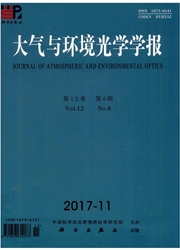

 中文摘要:
中文摘要:
相对于OH自由基是白天大气化学的驱动力,NO3自由基则是夜间大气中重要的氧化剂,NO3自由基浓度的准确测定对夜间大气化学的研究具有重要意义。然而由于大气中NO3自由基寿命短、浓度低(几百ppt),使得对其测量具有挑战性。上世纪八、九十年代,主要采用差分光学吸收光谱(DOAS)技术和基质隔离电子顺磁共振光谱(MI—ESR)技术对NO3自由基进行测量。随着科学技术的快速发展,本世纪初逐渐发展出腔衰荡光谱(CRDS)技术、腔增强吸收光谱(CEAS)技术、激光诱导荧光光谱(LIF)技术和化学电离质谱(CIMS)技术来探测NO3自由基。综述了国内外大气NO3自由基探测技术的研究现状和发展趋势,对各种方法的原理、优缺点及应用进行了较为详细的介绍,并总结了其在大型外场观测中测量NO3自由基所取得的研究进展。
 英文摘要:
英文摘要:
The oxidizability of NO3 radical in the night is comparable with that of diurnal OH radical. Given the importance of NO3 radical in the nocturnal chemical process, accurate measurement of its concentration in the atmosphere has become an essential topic in current research. NO3 radical has the short lifetime and low concentration (approximately several hundred ppt), which brings a challenge to detect NO3 radical In the 1980s and 1990s, differential optical absorption spectroscopy (DOAS) and matrix isolation electron spin resonance (MI-ESR) are mainly applied to detect NO3 radical. With the rapid development of technology, cavity ring-down spectroscopy (CRDS), cavity enhanced absorption spectroscopy (CEAS), laser induced flu- orescence (LIF) and chemical ionization mass spectrometry (CIMS) are gradually developed to detect NO3 radical at the beginning of this century. The detection processes of NO3 radical are reviewed, the principles of several methods, the advantage and disadvantage of them are introduced in brief. In addition, the process of field observations are outlined.
 同期刊论文项目
同期刊论文项目
 同项目期刊论文
同项目期刊论文
 期刊信息
期刊信息
